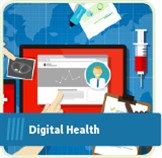Digital Health
Key Message


Digital Health and Care (formally eHealth)
Technology is changing the ways in which we interact, deliver services and monitor health and well-being. It also plays a significant part in how we address the current and future challenges faced by healthcare. There are numerous benefits of the use of the technology in healthcare. Some of these are:
- Patient access to healthcare support and information closer to their home
- Professionals have the potential to reach and support more patients
- Communication between services and service users in remote in rural setting is vastly improved
The effective practitioner has a responsibility to continually develop the knowledge and skills required to use and support the use of technology in healthcare. The effective practitioner can also acknowledge and utilise the potential that digital mechanisms have in sharing information and working collaboratively both locally and nationally.
To assist you in developing knowledge and skill on the national and local impact of digital health and care you may consider exploring some of the resources highlighted on this page.
What does this mean for the Effective Practitioner?
Technology is used more and more frequently within healthcare. Practitioners have a responsibility to continually develop the knowledge and skills required to use this technology as well as understand the principles of governance that support it's use. As a practitioner you need to be aware of the range of digital technologies that are being used in your own workplace. The effective practitioner is always considering the potential that technology offers in supporting patients/clients and allowing you to communicate more effectively with other practitioners locally and nationally.
![]() You can download a copy of
the Digital Health learning
activities.
You can download a copy of
the Digital Health learning
activities.
Reflection
Remember, recording your reflections is an important part of the learning process. Take time to structure your thoughts, feelings and any future actions on one the forms available in the Reflective Practice section. Click here to visit the page.
In your reflections you could also consider how your learning relates to the Facilitation of Learning, Leadership and Evidence, Research and Development pillars of practice.
Return to topSupplementary Resources
Signposts
![]() eHealth Good Practice
Case Studies
eHealth Good Practice
Case Studies
![]() Scottish Centre
for Telehealth & Telecare
Scottish Centre
for Telehealth & Telecare

